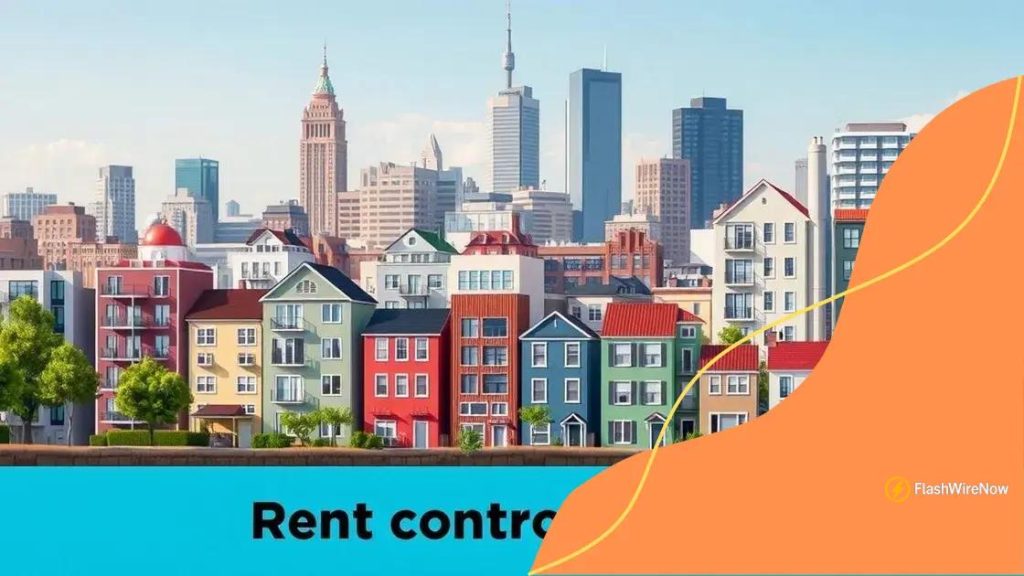Rent control policy impacts on housing affordability

Anúncios
Rent control policies are regulations that limit rent increases and protect tenants from eviction, aimed at making housing affordable, though they can also have economic implications like reduced housing supply.
Rent control policy impacts a significant number of individuals searching for affordable housing options. In a world where housing costs keep rising, understanding these policies can make a real difference in your experience as a renter. Let’s delve into how these regulations shape the rental landscape.
Anúncios
Understanding rent control policies
Understanding rent control policies is essential for anyone interested in housing rights and economic stability. These policies aim to keep rent affordable for tenants and maintain housing accessibility in cities where the cost of living is high.
Rent control can vary significantly by region. In many cases, these policies have been implemented to combat rapid increases in rent, helping to protect low- and middle-income residents from displacement. To grasp their significance, it’s crucial to look at the core features.
Key Features of Rent Control Policies
Most rent control systems share several key features, designed to enhance tenant security:
Anúncios
- Limits on annual rent increases
- Protection against eviction without just cause
- Regulation of rental terms and conditions
These features often create a more stable environment for tenants and their families. Understanding how these policies impact the housing market can shed light on broader economic trends.
Effects on Housing Supply
While providing immediate benefits to tenants, rent control policies can also have complex effects on the housing supply. When rents are controlled, landlords may be less incentivized to invest in property maintenance or to build new housing. This can lead to a decrease in overall housing availability over time.
Yet, for many, the immediate relief is critical. Balancing these needs is often a topic of heated debate among policymakers and community members.
Federal and State Variations
Different regions implement rent control in varying ways. Some states give cities the autonomy to enact their specific regulations, creating a patchwork of rules that can confuse tenants. For example:
- California has statewide rent control with specific local enhancements.
- New York City has a unique system with its rent stabilization guidelines.
- Other states may not allow rent control at all.
This variance complicates the broader understanding of rent control and encourages tenants to become informed about their local laws.
Ultimately, diving deep into the details of rent control policies reveals a landscape that is both vital for tenant protection yet fraught with challenges regarding housing supply and economic balance. Engaging in discussions surrounding these policies is crucial for shaping future housing strategies.
Historical context of rent control
The historical context of rent control reveals how housing policies evolved in response to economic pressures and social needs. In many countries, rapid urbanization and increasing population led to significant housing shortages, prompting governments to take action.
After World War II, many cities faced notable rent increases, which led to widespread concerns about affordability. Rent control measures were introduced as a way to stabilize housing costs and protect tenants. These policies were initially welcomed by the public, as they helped many families stay in their homes.
Key Events Influencing Rent Control
Several significant events shaped the development of rent control across different regions:
- The Great Depression saw a surge in demand for affordable housing.
- Post-war economic expansion increased the need for stable rental markets.
- Housing crises in urban areas prompted legislative changes around the globe.
These events highlighted the balance needed between protecting tenants and ensuring landlords could sustain their properties. Understanding this historical backdrop is vital to grasp the ongoing debates regarding rent control policies.
Regional Variations in Rent Control Policies
Different countries have adopted rent control policies in unique ways, often reflecting local economic conditions and cultural attitudes. In the United States, for example, rent control varies by state and sometimes by city, leading to a patchwork of regulations.
Some areas, like New York City, have long-standing rent stabilization laws, while others may have more flexible systems that allow for higher rent increases. These differences reveal how historical context influences ongoing housing policies on a local level.
In addition, other countries, such as Germany and Sweden, have developed their own models of rent control. Each has unique features tailored to its housing market and societal values. Examining these international examples can provide valuable insights into the effectiveness and challenges of rent control.
Effects on tenants’ rights and housing stability

Effects on tenants’ rights and housing stability are significant topics in the discussion about rent control policies. These policies are designed to protect renters, ensuring they have a stable home without excessive financial strain.
When rent control measures are in place, tenants often enjoy enhanced rights. This can include protections against sudden rent hikes and ensuring they cannot be evicted without cause. These factors contribute to a sense of stability for tenants in an otherwise volatile housing market.
Key Rights under Rent Control
Among the various protections, several key rights typically emerge:
- Limitations on rent increases, often tied to inflation rates.
- Protection from eviction without just cause.
- The ability to renew leases under the same terms.
These rights are essential for providing tenants with peace of mind. For many, they represent the difference between stability and the fear of displacement.
Housing Stability and Community Impact
The impact of rent control extends beyond individual tenants; it profoundly affects entire communities. When families can remain in their homes, local schools often see better attendance, and neighborhoods retain their character. People are more likely to invest time and resources if they feel secure in their residences.
However, there can be unintended consequences. In some cases, landlords may reduce maintenance on units, leading to a decline in housing quality over time. This emphasizes the importance of balancing tenant protections with fair practices for landlords.
Ultimately, the relationship between tenants’ rights, housing stability, and community health is complex. Understanding these dynamics is crucial for policymakers and community advocates alike to ensure fair housing practices while protecting the interests of residents.
Economic implications of rent control
The economic implications of rent control can be complex and wide-ranging. These policies influence the housing market not only for tenants but also for landlords and the broader economy. Understanding these effects is vital for assessing the overall impact of such regulations.
Rent control aims to make housing affordable, but it can lead to unintended economic consequences. When landlords face limitations on how much they can increase rent, it may discourage them from investing in property maintenance and improvements.
Short-term Benefits
In the short term, rent control can provide essential relief to tenants. This stability allows families to maintain their homes without fear of sudden rent hikes. Some of the immediate economic benefits include:
- Increased disposable income for tenants, allowing for more spending in local economies.
- Greater stability in neighborhoods, as families remain in their homes.
- Less pressure on social services, as fewer people experience homelessness.
These benefits contribute to a healthier local economy, creating a sense of community among residents.
Long-term Consequences
However, the long-term effects on the housing market can be problematic. When rent controls are too strict, they may result in:
- Reduced housing supply due to landlord disincentives to build or improve properties.
- Stagnation in rental market prices, making it difficult to attract new investment.
- Potential declines in housing quality, leading to deteriorating urban environments.
In many cases, this can result in a shortage of available rental units, as fewer new constructions come onto the market. These changes can create an imbalance that affects the economy overall.
Ultimately, while rent control policies provide necessary protections for tenants, balancing these with the economic realities facing landlords and the housing market is critical for sustainable solutions.
Alternatives to traditional rent control
Exploring alternatives to traditional rent control provides valuable insights into how communities can address housing affordability without the challenges associated with rent regulation. Many cities have sought creative solutions to ensure that housing remains accessible while still encouraging investment in the housing market.
Traditional rent control often creates an imbalance, such as discouraging new housing developments. Therefore, communities are turning to various innovative measures to balance tenant protections with economic incentives for landlords.
Inclusionary Zoning
One popular option is inclusionary zoning. This approach requires developers to set aside a percentage of new housing units for low- and moderate-income residents.
- Creates affordable housing units within new developments.
- Encourages diversity and community integration.
- Helps keep local neighborhoods vibrant and economically mixed.
This policy helps increase the overall supply of affordable housing while still allowing for market-driven development.
Housing Vouchers
Another alternative is the use of housing vouchers. Through this program, governments provide financial assistance to low-income renters, which helps them afford market-rate housing.
- Gives tenants more options in choosing where they would like to live.
- Allows for flexibility in responding to the needs of renters.
- Can boost local economies by increasing disposable income for families.
Housing vouchers empower tenants and can help them escape areas with concentrated poverty.
Rent Stabilization Agreements
Some cities have adopted rent stabilization agreements, which allow for moderate rent increases based on inflation rates rather than strict controls.
- Ensures affordability while allowing some revenue growth for landlords.
- Encourages property maintenance and investment.
- Promotes a stable rental market.
This compromise can protect tenants while still assuring landlords can manage costs effectively.
Ultimately, finding relevant and effective alternatives to traditional rent control is crucial for developing sustainable housing strategies that foster both tenant satisfaction and landlord investment. Exploring these options helps ensure a balanced approach to housing policy in communities facing affordability challenges.
In conclusion, understanding the impacts of rent control policies is essential for creating a balanced and fair housing market. While rent control can protect tenants from sudden increases and foster community stability, it also has economic implications that require careful consideration. Exploring alternatives like inclusionary zoning, housing vouchers, and rent stabilization can lead to effective solutions that address the needs of both tenants and landlords. Engaging in open discussions about these policies and their effects will pave the way for innovative approaches to housing affordability.
FAQ – Frequently Asked Questions about Rent Control Policies
What is rent control?
Rent control refers to laws that limit how much rent landlords can charge and how much they can increase rents each year.
How does rent control affect tenants?
Rent control helps protect tenants from sudden rent increases and provides stability in housing costs, ensuring they can afford to stay in their homes.
What are some alternatives to traditional rent control?
Alternatives include inclusionary zoning, housing vouchers, and rent stabilization agreements, which aim to maintain affordability while encouraging housing development.
What economic impacts can rent control have?
While rent control can ease affordability for tenants, it may also discourage landlords from maintaining or investing in their properties, leading to fewer available rental units.





